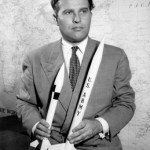With hundreds and hundreds of feature films being churned out of Hollywood every year, I suppose it shouldn’t surprise too much when two separate production companies, unrelated to and independent of each other, find themselves working on a version of the same subject at the same time. Nonetheless it does seem something of an oddity, or at least a novelty, when it does occur, which isn’t very often in the history of cinema.
 Source: pastposters.com
Source: pastposters.com
At least three instances of identical subjects being simultaneously made into features spring to mind. Who doesn’t know that the mythical or semi-mythical (depending on your point of view) English hero of Medieval fable and legend, Robin Hood, has been the subject of American and British feature films almost too many times to count? Ever since the early days of silent movies the silver screen (and later the TV screen) has been awash with iterations of Robin and his Lincoln green-daubed coterie of “Merry Men” locking horns with the Sheriff of Nottingham, Sir Guy of Gisborne and other assorted knaves and villains. But in the year 1991 moviegoers got two Robin Hood sagas🄰 to choose from, a big budget Hollywood number, Robin Hood: Prince of Thieves with Kevin Costner in the eponymous role. In a film stolen by Alan Rickman’s outrageously over-the-top, campy Sheriff of Nottingham🄱, apple pie American Costner’s non-attempt as an appropriate English accent was a talking point of the film. The behind-the-scenes scuttlebutt was that his initial plan to try to pull off a passable English accent was vetoed by the director (‘Actors who gave up on accents halfway through a movie’, Ben Falk, Yahoo, 13-Nov-2020, www.uk.movies.yahoo.com).
𝕐𝕠𝕦𝕣 𝕔𝕙𝕠𝕚𝕔𝕖 𝕠𝕗 𝕒𝕔𝕖 𝕓𝕠𝕨𝕞𝕒𝕟: 𝔸𝕟𝕘𝕝𝕠-𝕀𝕣𝕚𝕤𝕙 𝕠𝕣 ℂ𝕒𝕝𝕚𝕗𝕠𝕣𝕟𝕚𝕒𝕟 ℝ𝕠𝕓𝕚𝕟?
𓃰𓃰𓃰
Flashy ‘Prince of Thieves’ vs gritty, shadowy ‘Robin Hood’
The other 1991 RH vehicle, simply entitled Robin Hood, a UK production, was a smaller scale, more modest affair than ‘Prince of Thieves’. The two filmic versions—Hollywood vs Britain, Kevin Costner vs Patrick Bergin—were expected to go head-to-head in a battle at the box-office, but this was averted when the producers of the UK Robin Hood decided to send their version straight to cable (Fox) TV.
A surprising lack of rivalry existed between the two concurrently-working production teams. Because a number of the shoot locations were reasonably close to each other (Buckinghamshire, Cheshire, West Yorkshire, North Wales) there was a good bit of collaboration, eg, crew swaps between each movie’s SFX and stunt teams (‘The Surprise Cooperation between 1991’s two Robin Hood films’, Dan Cooper, Film Stories, 09-Apr-2021, www.filmstories.co.uk).
🏹 🏹 🏹
𝔻𝕦𝕖𝕝𝕝𝕚𝕟𝕘 ℍ𝕒𝕣𝕝𝕠𝕨𝕤: ℂ𝕒𝕣𝕠𝕝 𝕧 ℂ𝕒𝕣𝕣𝕠𝕝𝕝
𓃯𓃯𓃯
Two films about Hollywood’s original “Platinum Blonde”
1965 saw the release of two biopics about Jean Harlow, star Hollywood actress and screen sex symbol of the 1930s, both were titled simply Harlow. The first, a Magna Distribution Corp TV biopic starred Carol Lynley in the titular role and the second, from Paramount released five weeks later with a budget more than double. Carroll Baker played the Thirties sex siren. Magna and Paramount subsequently countersued each other alleging unfair competition. Both movies were critical and box office failures with nary a good word to say by anyone about either of them…DVD Talk summed them up as “two smutty movies” with little resemblance to the real Jean Harlow (‘Harlow (1965) v Harlow (1965)’, www.realtoldmovies.blogspot.com).
𓃭𓃭𓃭
Dual Doomsday message
The third concurrent double act on the screen has the most interesting relationship. In 1964 Hollywood made two Cold War-inspired films with a storyline about the US military launching a Doomsday bomb aimed at the Soviet Union. The tones of the respective movies are diametrically opposite however, Dr Strangelove is a farce and satire, comically lampooning the absurdity of the global nuclear standoff, whereas Fail Safe is a grimly serious dramatic thriller which plays it very straight. Dr Strangelove director Stanley Kubrick was alarmed to discover that Sidney Lumet was making a near identical movie…so concerned was Kubrick that Fail Safe with its similar content might undermine his pet project he got the production company Columbia Pictures to buy the distribution rights to Lumet’s film in order to delay its release for nine months. The wash-up from this head-start was that Dr Strangelove did far better business at the box office than the similarly themed Fail Safe and is the much better-known of the two movies today.
 Images: Columbia Pictures
Images: Columbia Pictures༓༓༓༓༓༓༓༓༓༓༓༓༓༓༓༓༓༓
🄰 there were actually three Robin Hoods in the works simultaneously at that time. The third RH intended to have Liam Neeson in the role ended up being canned prior to production starting
🄱 as one critic summed it up, “While Costner had been robbing from the rich, Rickman had been stealing the movie“, ‘Behind-the-scenes trouble during ”Robin Hood”’, Garth Pearce, Entertainment Weekly, 21-Jun-1991, www.ew.com











